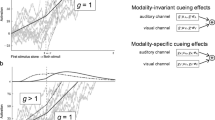Abstract
The effect of auditory cues at different levels of visual processing was examined by using a visual ”conjunction of features” discrimination task (experiment 1) and a ”feature” discrimination task (experiment 2). In both experiments the visual target, appearing either on the left or the right of Ss’ midline, was preceded by a brief tone either spatially proximal or distal to the target. In the ”conjunction” task, subjects had to discriminate the orientation of a T flanked with T distractors of different orientations. In this task, assumed to require focused attention, discrimination accuracy was increased when the sound cue occurred at the subsequent visual target location and was decreased when it occurred at its alternative location. In the ”feature” experiment, subjects had to discriminate the orientation of a line segment (±45°) presented among line segment distractors. Accuracy was not affected, either when the sound was proximal or when it was distal to the location of the visual target. Results suggest that the early processing of sensory information is modality specific and that interference of auditory stimulation with visual stimuli is more pronounced as the processing of visual stimuli requires focused attention.
Similar content being viewed by others
Author information
Authors and Affiliations
Additional information
Received: 5 June 1998 / Accepted: 12 January 1999
Rights and permissions
About this article
Cite this article
Dufour, A. Importance of attentional mechanisms in audiovisual links. Exp Brain Res 126, 215–222 (1999). https://doi.org/10.1007/s002210050731
Issue Date:
DOI: https://doi.org/10.1007/s002210050731




